Projekt
- Gröna kommuner på väg
- Vi Vill Veta
- Jag Vill Veta
- Fixa Elbil
- Fossilfrihet till varje pris?
- Hela gröna vägen - fossilfria transporter 2030, Ja tack!
- Färdplan 2030
- På vägen
- KTH Mobility Pool
- Nollzon
- Stadsmobilitet
- Landsomfattande kommungranskningar
- Individuella kommungranskningar
- KomKomKom
- Inte bilen under milen
- Medbestämmande Syd
- Gasbilsturnén 2009
- Energieffektiva bilar
- Hållbara Drivmedel
På vägen - Ideas for the Sustainable Road
Nytt projekt med syfte att stimulera debatten om ett hållbart trafiksystem genom visualisering av olika koncept, innovationer så som fordon och transporttjänster.
På Vägen post 1 (30)
Introduction: På Vägen - Ideas for the Sustainable Road based on emerging technologies, research and holistic expertise. The following weeks I will share new concepts for vehicle systems together with ITRL/Integrated Transport Research Lab at the Royal Institute of Technology. The aim is to inspire a faster pace on the road towards sustainable transportation. Suggesting a continuation:
- Governments and corporations add funding of visionary projects
- Setting up a Proving Garage for new concepts
- Allowing fast lane student and research projects
The coming post series follows Den Stora Kurvan (The Big Curve) a 22-bullet list of changes. Full Swedish text https://www.yachtandcar.se/ Or listen to this English pod interview http://garaget.libsyn.com/webpage/2017/09
This initiative also supported by Gröna Bilister/Green Drivers assoc.
På Vägen post 2 (30)

© 2017 Per Gyllenspetz
The new vehicle systems concepts are based on emerging technologies, research and holistic expertise. Many things are new in the car business and soon the car may be replaced by something quite different. In some places the change will happen fast, in others it will take decades before everybody uses mobility systems and there are no more driver jobs. But the asphalt will still be there so the question is what do we use it for, what is smart to put moving there? På Vägen will show my visions. Let’s begin with some facts.
På Vägen post 3 (30)

© 2017 Per Gyllenspetz
The Big Curve of transportation change. This is not a scenario. These are possibilities and risks for our actions - some may drive too fast on the straight line and off the cliff doing a Kodak. I assist with safer sustainable navigation. In my own work with transport vision projects I use this perspective of the big view. The turn we are entering gives a lot of opportunities for planet safety and better business. This updated list of bullet headlines has a Swedish detailed text at yachtandcar.se
På Vägen post 4 (30)

© 2017 Per Gyllenspetz
An automotive revolution coming up? The Multifunctional Wheel Module philosophy is to include all mechanical components + smartness, creating many new features. Such as outstanding traction in slippery road conditions. Or an ability to actively pre-adjust the suspension by reading the road topology, meaning you may never notice passing over a road pothole. Several connected research projects show promising results.
På Vägen post 5 (30)
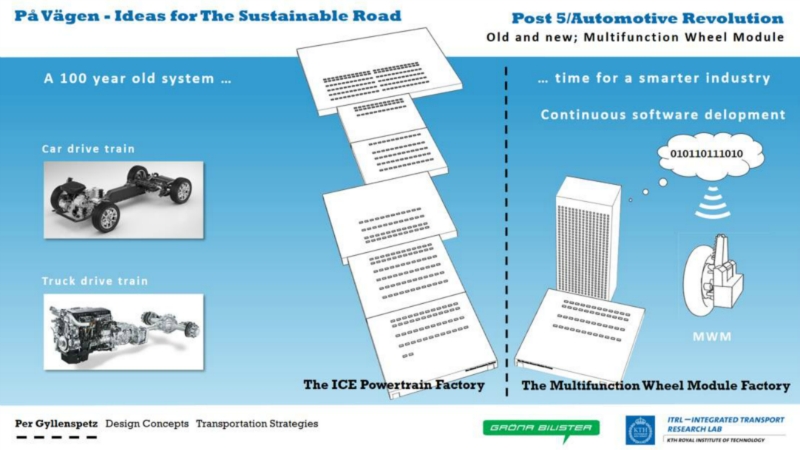
© 2017 Per Gyllenspetz
Smaller and smarter - the Multifunction Wheel Module.
På Vägen post 6 (30)

© 2017 Per Gyllenspetz
Diesel/gasoline (ICE) cars and trucks bring along heavy bulky systems with many parts that define the geometry of how vehicles are built today. Much of this is currently inherited in electric vehicle build and that is illogical. Instead there is great potential to do something completely different and also gaining several other advantages. The Multifunctional Wheel Module.
På Vägen post 7 (30)

© 2017 Per Gyllenspetz
The MWM´s allow free vehicle architecture on flat platforms. No transaxels, tanks, mufflers, exhaust pipes. The chassis can adjust floor height to the curb for easy access. A platform with 4m length using four Multifunction Wheel Modules can transport up to 8 people or up to 10 m3 of goods. Many research projects and student activities are made, user experiments as well as chassis and autonomous drive tests.
På Vägen post 8 (30)

© 2017 Per Gyllenspetz
Problems with growing cities? Let’s try solve rural life and people may want to stay - in the Arctic as well as in Africa. Using MWM´s we can create vehicles that have traction in any road condition. The idea with the Land Mobility and Delivery vehicle is to take children, elderly, everyone where they want to go and do it safely. Also freight packages or furniture any time. Buzzwords: Mobility as a Service/MaaS and Logistics as a Service/LaaS and Connected/Shared/Autonomous/Regulated.
På Vägen post 9 (30)

© 2017 Per Gyllenspetz
People make cities attractive. Cars don’t. Cars take up lots of valuable space when moving an average of 1,2 persons or when parked 96% of the time. Researchers calculations show that a connected/shared/autonomous /regulated mobility system (MaaS) can reduce the number of vehicles by a factor of at least 10 times. If systems for synchronizing goods freight (LaaS) are integrated in city traffic and focused at non-rush hours the fluidity of city traffic may increase further. This smaller MWM vehicle (3 x 1.6 x 1.7 m) brings 4 people the last mile or all the miles. At off-peak the vehicle may convert into a freighter of 1,5 m3/0,5 ton goods.
På Vägen post 10 (30)

© 2017 Per Gyllenspetz
Why box design? These are the advantages: Maximising interior volume. Optimised placement of synchronized sensors. Aerodynamics not a priority at speeds below 60 km/h. Shade from sun/solar panel surface is maximsed. Rain, snow, frost on windows is reduced. Rain and snow entering interior is reduced. All this resulting in reduced energy use for heating/cooling/drying. In some weather conditions the climate system may use more energy than the electric drive propulsion!
På Vägen post 11 (30)

© 2017 Per Gyllenspetz
One parent, two children or another adult, some bags and 2,5m x 1,3m/weight 400 kg, four X 2kW MWM´s, good for 45-80 km/h. That’s my idea for a Parent Mobile. It is of course connected/shared/autonomous/regulated. This proposal is a solution based on wishes from users in the KTH Mobility Pool research project. User want to bring two kids and they can’t the 2-seater Twizys we offered. So by offsetting and overlapping seating positions we can create a nice social room for all in a small efficient vehicle.
På Vägen post 12 (30)

© 2017 Per Gyllenspetz
Land Wagon. Now is a time to look at transportation from a new perspective. We have some prerequisits: A nomad species that always has (or finds) reasons to travel that is us, people. We have a lot of paved asphalt surface on our globe. The wheel has been invented for some time. So what can we do with this? The suggestion I have here is a combination of a coach, a train and airplane technology, rolling on 12 MWM’s. It’s connected/shared/autonomous/regulated in a mobility system. Possibly also tapping electricity off electric roads. The Land Wagon would serve much of the needs for long distance travel that cars do today and also take a load of crowded railways. Continued after holidays!
På Vägen post 13 (30)

© 2017 Per Gyllenspetz
Land Wagon contd. A new way to travel. Length 25 m. Curb weight 14 tons. Payload 6 tons. Is higher speed top priority for our trips? Or is peace of mind for working, relaxing or just pure enjoyment as important? The theory of the Land Wagon is that direct travel is preferable to many if it is comfortable and undisturbed. Electric road adaption will cut emissions to very low. Speeds up to 200 km/h. Outstanding all-wheel traction that is not dependent on snowplowing. Smooth ride with stability and bump-sensing systems. Light weight fuselage and easy access low floor with low center of gravity. Continued in next post. The Land Wagon is a vision to be sharpened and there is an opportunity to discuss this at the ITRL lecture January 11. Register here: https://www.itrl.kth.se/events/calender-itrl/ideas-for-the-sustainable-road-11-vehicle-concept-ideas-1.784161
På Vägen post 14 (30)

© 2017 Per Gyllenspetz
Land Wagon contd. Imagine ride hailing in a large scale, an on-demand crowd-booking system offering tailored semi-nonstop long distance trips to and from ANY location. Hockey game goers travel safely to the event. Conference visitors work uninterrupted on their way door to door. The Land Wagon system should take a load off current railways. Is this alternative for people and light goods preferable before new fast railway lines? Land Wagons can bring efficient public transportation and logistics to all communities at a low cost. The system should include smaller vehicles as well. As always: connected/shared/autonomous/regulated.
På Vägen post 15 (30)
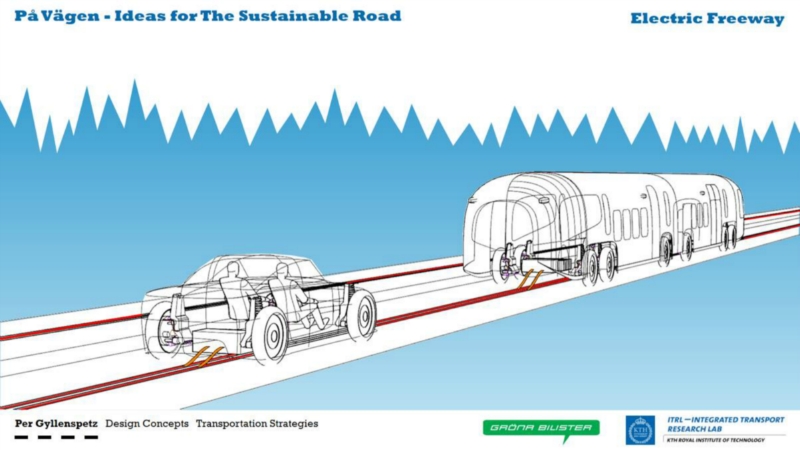
© 2017 Per Gyllenspetz
Electric Freeways are a relatively fast way to cleaner transport. Sectioned electric freeway stretches provide direct current as well as intermittent charging. Several different systems for electrifying roads are tested and promising. Battery packs in vehicles can be smaller. Next, Job 1 is to reduce concept systems weight and to integrate into cars. Job 2 can provide further solutions for ground contact, induction and air line.
På Vägen post 16 (30)

© 2017 Per Gyllenspetz
Terrain Work Vehicle. Possibilities with Multifunction Wheel Modules/MWM: All-wheel multi-direction steering, individual torque vectoring (wheels get different power), data controlled chassis distribute ground
pressure + increases traction, topology scan connected to steering assist, large variable inflation low pressure tyres (0.5 bar) add to make minimal ground impact.
På Vägen post 17 (30)

© 2017 Per Gyllenspetz
Contd. Terrain Work Vehicle. The MWM’s will allow outstanding off-road capabilities for service vehicles etc. This vehicle ideation has low center of gravity, low load bay, solar panel power support, tilted windshield for sun blocking and better visibility.
På Vägen post 18 (30)

© 2017 Per Gyllenspetz
New technology in forest harvesting may decrease environmental impact considerably. Using electric Multifunction Wheel Modules, light weight and electric mechanicals, soft ground contact and autonomous technology for carts, the systems effect should be very interesting to investigate in real life trials. Continued.
På Vägen post 19 (30)

© 2017 Per Gyllenspetz
Contd. Light Forest Machine.
På Vägen post 20 (30)
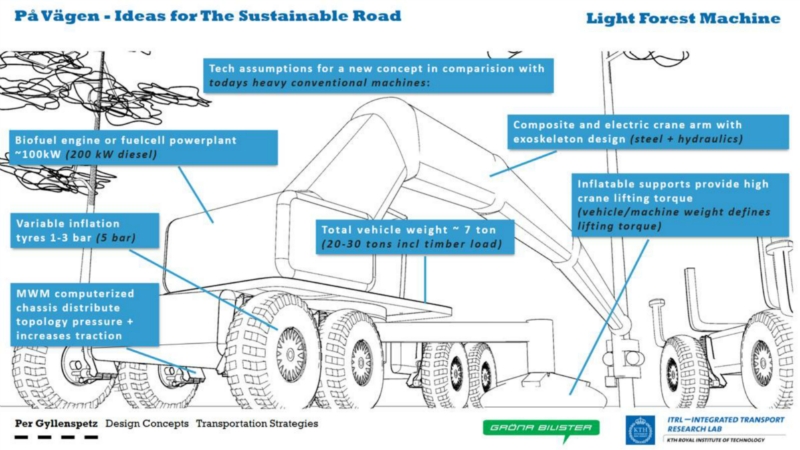
© 2017 Per Gyllenspetz
Contd. Light Forest Machine.
På Vägen post 21-22 (30)

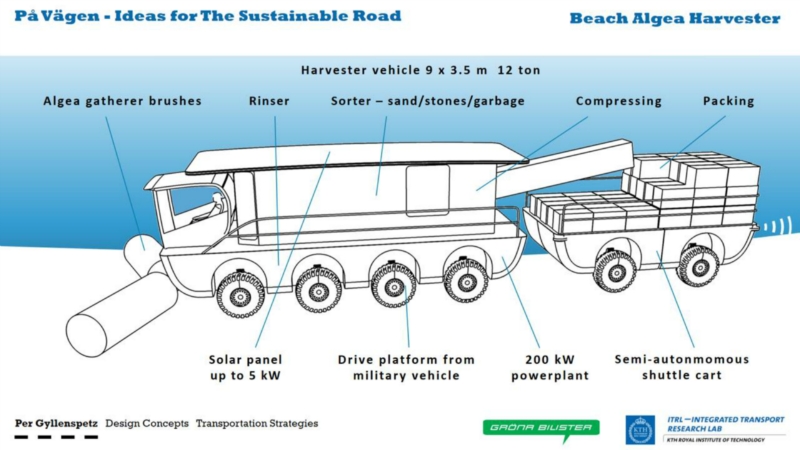
© 2017 Per Gyllenspetz
Beach Algea Harvester. The function of this vehicle is to harvest valuable material for biofuel production while making beaches attractive again. Thousands of tons of algea end up on beaches due to excess nutrients in the Baltic Sea area. Some of the algea belong in the biotopes and should remain. The harvesters have amphibious function, the carts are semi-autonomous and can unload packed algea/seaweed at roadside for truck pick up. The vehicle is based on military platforms.
På Vägen post 23 (30)

© 2017 Per Gyllenspetz
Urban WaterTruck. This is a logistics system aimed at taking much of city freight off the streets and on to the rivers and canals. Many cities were built around the waterways once upon a time so it is a proven concept. The project is under way and the outlook is to reduce overall city emissions and congestion. The possible solutions include different types of load carriers.
På Vägen post 24 (30)
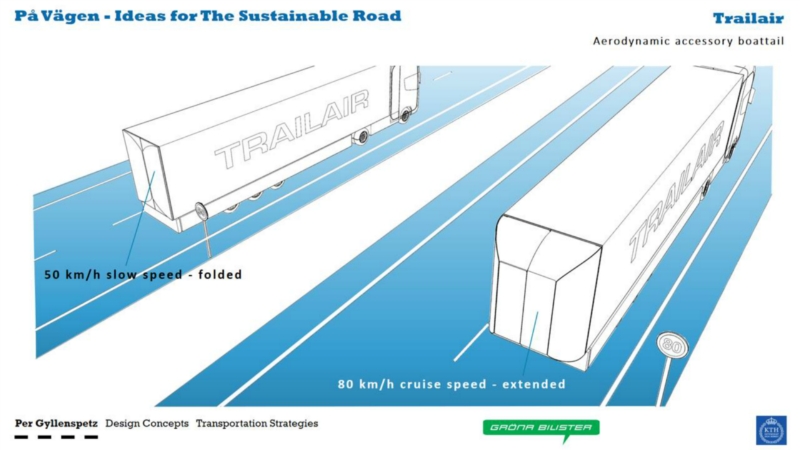
© 2017 Per Gyllenspetz
Trailair. A simple and inexpensive way to reduce emissions and save fuel cost by as much as 10-20%. A so called boat tail accessory is mounted on the rear of trailer and extends automatically when reaching cruising speed. This project is not yet under way despite the very obvious advantages. The industry and authorities have an opportunity to look at this now.
På Vägen post 25 (30)

© 2017 Per Gyllenspetz
While most of the initiatives in this series are far ahead, the Mobile Fuel Station is not and it could be running soon. Newer or specialized fuels like methanol and hydrogen, also biogas, HVO, etc can start a market by the outreach of a ”foodtruck” for fueling commercial fleets or community vehicles at their hubs.
På Vägen post 26 (30)
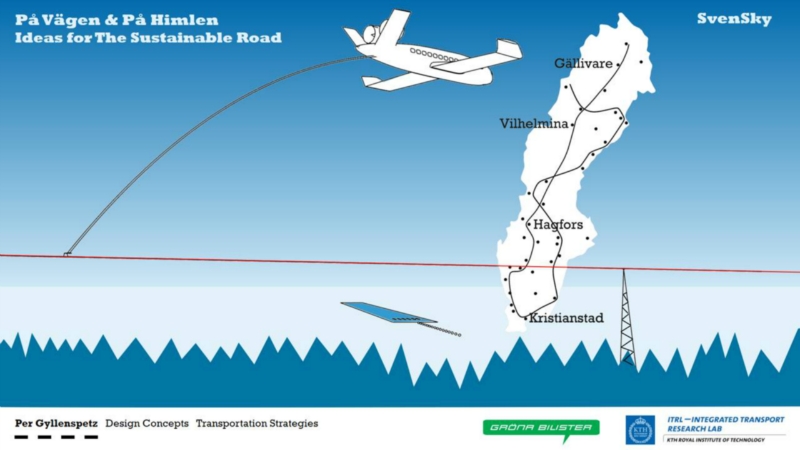
© 2017 Per Gyllenspetz
SvenSky: Electrified passenger planes with tethered conductor robots running along a network of powerlines. This could serve as an option to surface travel and kerosene aircraft. Sweden’s regional airports can come to better use in this network system and would be more flexible and have lower cost than building fast railways. SvenSky would also be able to serve a bigger part of the country. This is an unexplored longshot and I will discuss it in next posts. Continued.
På Vägen post 27 (30)

© 2017 Per Gyllenspetz
SvenSky. 80 passengers. Weight 20 ton. Payload 8 ton. Length 30 m.
2 x 700 kw electric motors. Fuel cell powering in off-grid take-off and landings. 200-300 km/m cruising speed. Flying altitude should be near ground ~100m. Continued.
På Vägen post 28 (30)

© 2017 Per Gyllenspetz
SvenSky contd.
PROS +Much lower building cost rel fast railway +Very low emissions rel kerosene aircraft +More flexible system than fast railway +Greater coverage than fast railways +Small cities get easy and more sustainable travel
CONS -Unproven longshot -Higher energy use per passenger rel train -Wind/pressure variations at low flying height -Isolation problems in power conductor system? -Static? -Birds hazard?
För mer information kontakta:
Per Gyllenspetz / per@yachtandcar.se / http://www.yachtandcar.se/
Mikael Nybacka / KTH ITRL / mnybacka@kth.se
Martin Prieto Beaulieu / Gröna Bilister / martin.prieto.beaulieu@gronabilister.se
Du kan boka en föreläsning "Den Stora Kurvan. Snart kommer nya smarta lösningar för att resa och få våra saker levererade." via www.saj.se
Relaterat material

